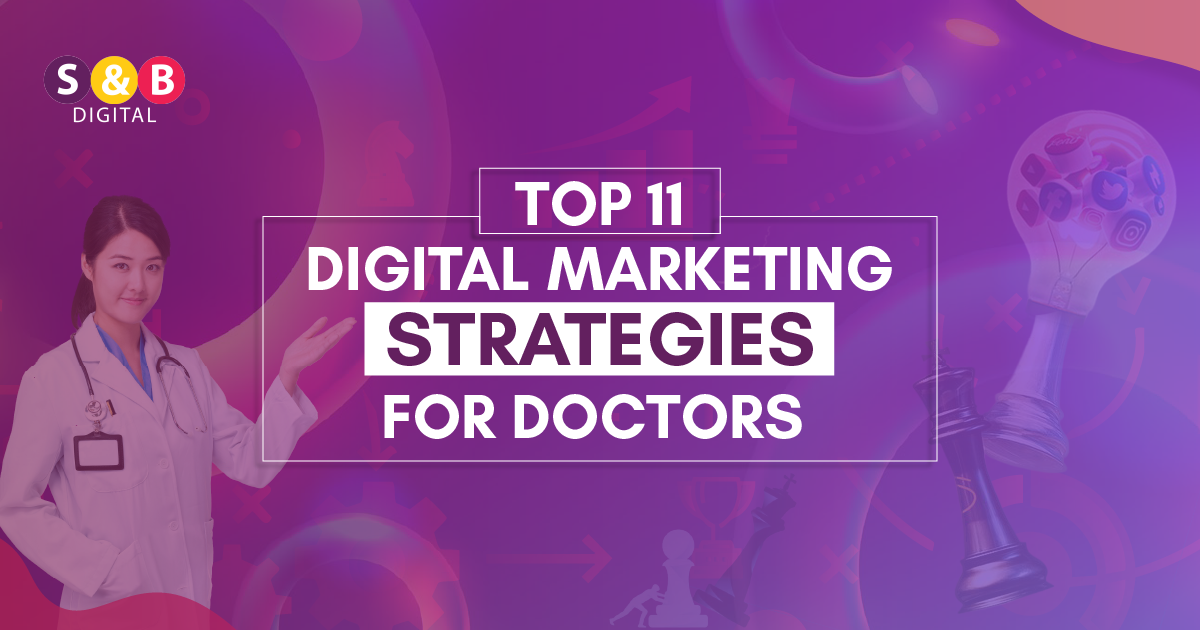In today’s digital-first world, healthcare isn’t just about excellent patient care; it’s about visibility, trust, and connection.
Whether you’re a general practitioner, dentist, dermatologist, or specialist, your potential patients are online, searching, comparing, and deciding who to trust with their health.
That’s why digital marketing has become essential for doctors who want to build credibility, grow their practice, and reach the right audience.
In this guide, we’ll walk you through 11 proven digital marketing strategies for doctors that can help you attract more patients, strengthen your brand, and stay ahead in 2025.
1. Build a High-Converting Medical Website
Your website is your digital clinic. It’s often the first impression patients get of your practice.
A well-designed website not only informs visitors about your services but also builds confidence.
Here’s what makes a great medical website:
- Fast loading speed (under 3 seconds)
- Mobile-friendly design
- Clear navigation (appointments, services, contact)
- Doctor’s profile & credentials
- Patient testimonials
- Secure HTTPS connection
Pro tip: Add a simple “Book Appointment” button on every page. This small call-to-action can increase conversions dramatically.
2. Optimize for Local SEO (Google My Business)
When people search “dentist near me” or “best pediatrician in [city]”, Google shows local results based on your Google Business Profile (GBP).
Why it matters:
Local SEO ensures your clinic appears in Google Maps and “near me” searches, the most common way patients discover nearby healthcare providers.
Steps to optimize your Google Business Profile:
- Claim and verify your listing
- Add correct NAP (Name, Address, Phone number)
- Upload professional photos of your clinic
- Include your website and appointment link
- Post regular updates or health tips
- Encourage patients to leave Google reviews
Example:
A verified listing with 30+ positive reviews ranks higher and attracts 50% more clicks than one with fewer than 10.
3. Invest in Content Marketing (Educate & Build Trust)
Patients don’t just want treatment, they want understanding.
That’s where content marketing helps doctors stand out as experts.
Start by writing helpful blog posts, guides, or infographics that answer real patient questions.
Content ideas for doctors:
- “How to Prevent Seasonal Allergies Naturally”
- “Difference Between Migraine and Headache”
- “What to Expect in a Root Canal Procedure”
Benefits:
Builds authority
Improves SEO rankings
Increases website traffic
Converts readers into patients
Tip: Focus on long-tail keywords like “best cardiologist for heart health in Mumbai” instead of broad terms.
4. Leverage Social Media for Patient Engagement
Social media platforms like Instagram, Facebook, and LinkedIn are perfect for building relationships with patients.
Instead of only promoting your services, share valuable, relatable, and human content.
What to post:
- Health awareness videos
- Behind-the-scenes clinic updates
- Before & after stories (with consent)
- Patient success stories
- Myth vs. fact posts
Example:
A dermatologist posting “5 Skincare Mistakes to Avoid This Summer” can get 10x engagement compared to a plain service post.
Pro tip: Use short video formats (Reels or YouTube Shorts); they get higher visibility and engagement.
5. Use Paid Advertising (Google & Meta Ads)
Organic reach is powerful, but paid ads give you targeted visibility instantly.
Google Ads:
Run campaigns targeting search queries like “best gynecologist near me” or “orthopedic doctor in Delhi”.
Meta (Facebook + Instagram) Ads:
Use audience filters to reach specific demographics like age, location, and interests.
Ad ideas for doctors:
- “Book your full-body check-up this weekend – slots open!”
- “Consult our dermatologist online – first visit free!”
Why it works:
Patients often click on the first few search results, and paid ads ensure you appear there.
6. Manage Online Reviews
Patients trust other patients. According to a BrightLocal study, 77% of people check online reviews before choosing a healthcare provider.
How to get more reviews:
- Ask satisfied patients directly (in person or via WhatsApp)
- Send automated follow-up emails
- Respond politely to all reviews — good or bad
Pro tip:
Never fake reviews; authenticity builds long-term trust.
A 5-star reputation not only improves credibility but also boosts your local SEO ranking.
7. Start Email Marketing Campaigns
Email marketing might sound old-school, but it’s still one of the most effective tools for patient retention.
What to send:
- Appointment reminders
- Health tips & seasonal care guides
- Wellness program offers
- Personalized birthday messages
Use tools like Mailchimp or HubSpot to automate campaigns and segment your audience (e.g., regular patients, new visitors, etc.).
Example:
A monthly “Healthy Heart Newsletter” from a cardiologist can keep patients engaged and encourage follow-ups.
8. Offer Online Appointments and Telemedicine
After the pandemic, convenience has become key. Patients expect easy online booking and virtual consultations.
By integrating telemedicine platforms (like Doxy.me or Practo), you can reach patients beyond your city.
Benefits:
- Increases accessibility
- Reduces appointment cancellations
- Builds modern, tech-savvy brand perception
SEO tip: Optimize a dedicated page for “Online Doctor Consultation in [City]”. This helps attract digital-first patients.
9. Run Video Marketing Campaigns
Video content converts like no other format.
It’s engaging, educational, and human.
Video ideas for doctors:
- 1-minute health tips
- Doctor introduction video
- “Day in the Life” clips
- Explainer videos for medical procedures
Upload videos to YouTube, embed them on your website, and share on Instagram Reels.
Why it works:
A short, clear video can help people feel comfortable before their first appointment.
10. Use Healthcare-Specific SEO Strategies
Search engine optimization for healthcare is unique; it must comply with Google’s E-E-A-T guidelines (Experience, Expertise, Authoritativeness, and Trustworthiness).
Key SEO tips for doctors:
- Use your full name and credentials on pages
- Add schema markup for medical professionals
- Optimize “Service + Location” pages (e.g., “Pediatric Clinic in Hyderabad”)
- Write blogs around real patient intent
- Keep all content medically accurate and updated
Bonus: If your clinic has multiple locations, create separate landing pages for each — it boosts local ranking.
11. Track and Analyze Performance Regularly
No marketing strategy works without data-driven decisions.
Use Google Analytics and Search Console to monitor:
- Traffic sources
- Most-visited pages
- Appointment form conversions
- Keyword rankings
Also track:
- Social engagement
- Ad conversion rates
- Email open & click-through rates
Regular reporting helps you understand what’s working — and where to improve.
Example:
If your “skin treatment” page gets high traffic but low conversions, improve the call-to-action or add testimonials.
Conclusion: Build Trust Before You Sell
At its heart, healthcare marketing is about building trust, not just traffic.
The more value and empathy you show online, the more patients will choose you over competitors.
Start small, improve your website, claim your Google listing, and post regularly.
Then scale with SEO, ads, and automation to truly dominate your local medical market.






